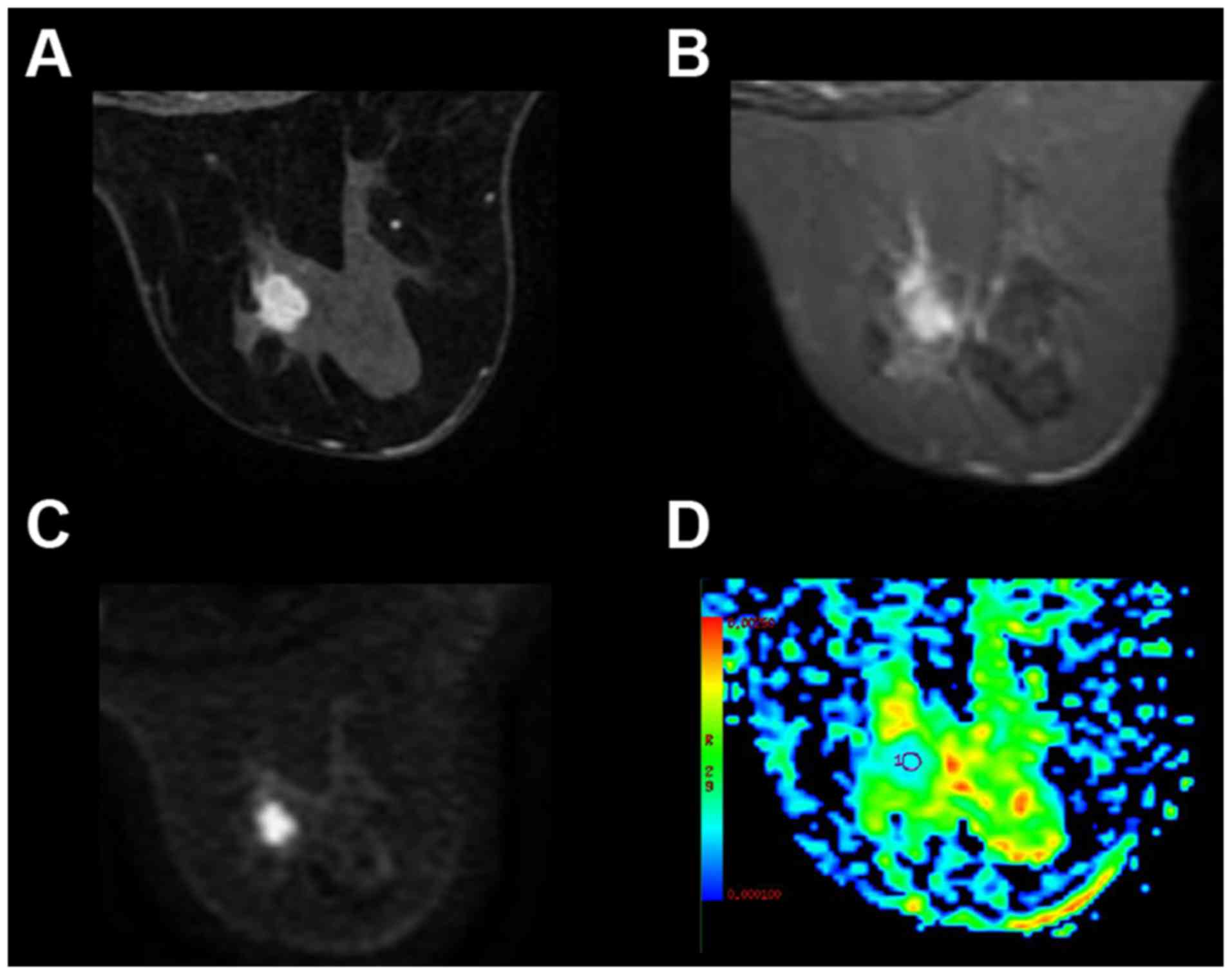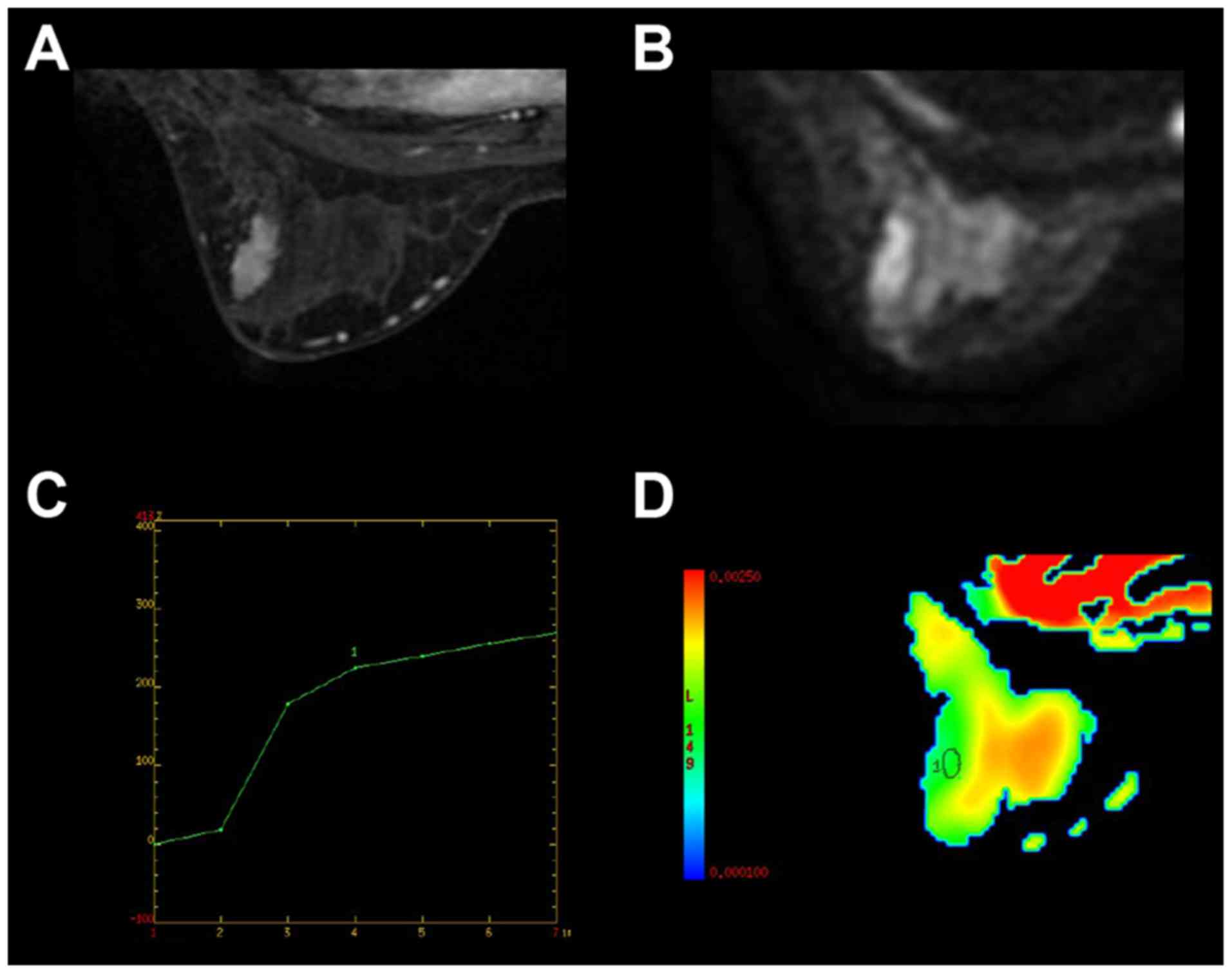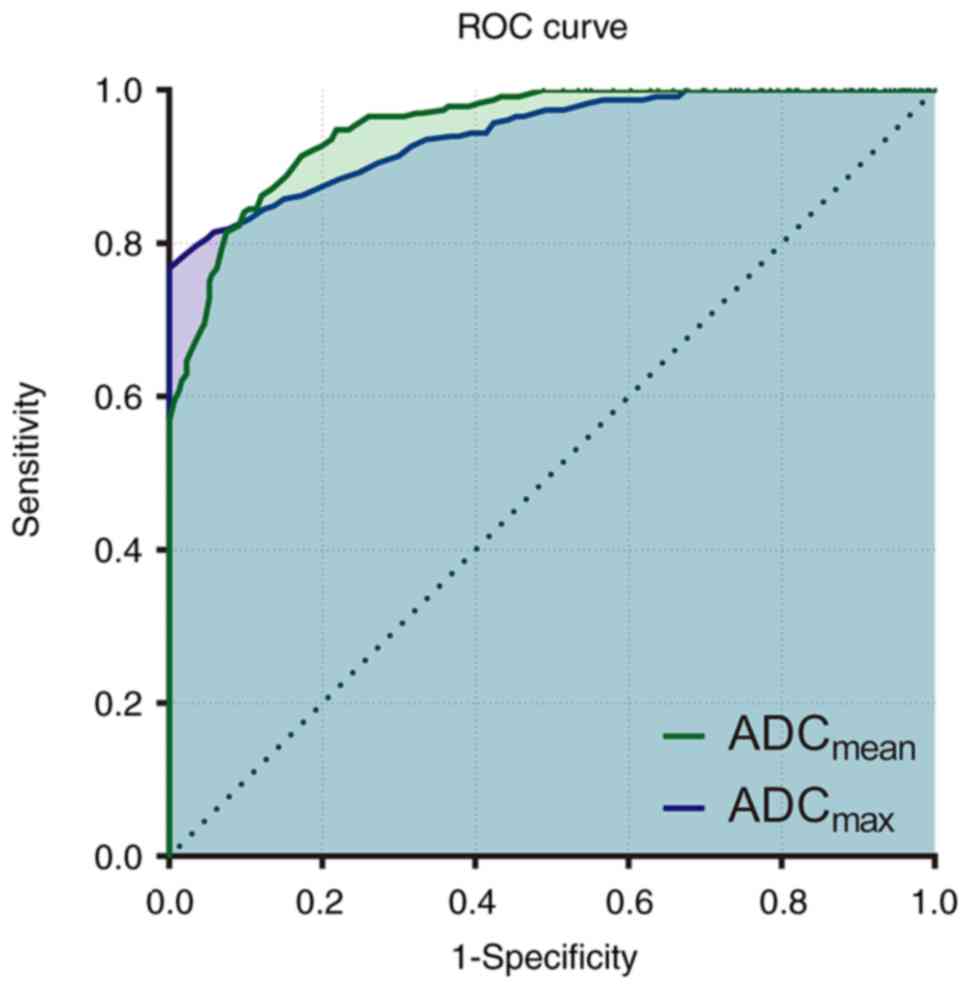|
1
|
van Bodegraven EA, van Raaij JC, Van
Goethem M and Tjalma WAA: Guidelines and recommendations for MRI in
breast cancer follow-up: A review. Eur J Obstet Gynecol Reprod
Biol. 218:5–11. 2017. View Article : Google Scholar : PubMed/NCBI
|
|
2
|
Quinn EM, Coveney AP and Redmond HP: Use
of magnetic resonance imaging in detection of breast cancer
recurrence: A systematic review. Ann Surg Oncol. 19:3035–3041.
2012. View Article : Google Scholar : PubMed/NCBI
|
|
3
|
Mehnati P and Tirtash MJ: Comparative
efficacy of four imaging instruments for breast cancer screening.
Asian Pac J Cancer Prev. 16:6177–6186. 2015. View Article : Google Scholar : PubMed/NCBI
|
|
4
|
Koh DM and Collins DJ: Diffusion-weighted
MRI in the body: Applications and challenges in oncology. Am J
Roentgenol. 188:1622–1635. 2007. View Article : Google Scholar
|
|
5
|
Chen X, Li WL, Zhang YL, Wu Q, Guo YM and
Bai ZL: Meta-analysis of quantitative diffusion-weighted MR imaging
in the differential diagnosis of breast lesions. BMC Cancer.
10:6932010. View Article : Google Scholar : PubMed/NCBI
|
|
6
|
Belli P, Costantini M, Bufi E, Giardina
GG, Rinaldi P, Franceschini G and Bonomo L: Diffusion magnetic
resonance imaging in breast cancer characterisation: Correlations
between the apparent diffusion coefficient and major prognostic
factors. Radiol Medica. 120:268–276. 2015. View Article : Google Scholar
|
|
7
|
Min Q, Shao K, Zhai L, Liu W, Zhu C, Yuan
L and Yang J: Differential diagnosis of benign and malignant breast
masses using diffusion-weighted magnetic resonance imaging. World J
Surg Oncol. 13:322015. View Article : Google Scholar : PubMed/NCBI
|
|
8
|
Partridge SC, DeMartini WB, Kurland BF,
Eby PR, White SW and Lehman CD: Quantitative diffusion-weighted
imaging as an adjunct to conventional breast MRI for improved
positive predictive value. Am J Roentgenol. 193:1716–1722. 2009.
View Article : Google Scholar
|
|
9
|
Peters NH, Vincken KL, van den Bosch MA,
Luijten PR, Mali WP and Bartels LW: Quantitative diffusion weighted
imaging for differentiation of benign and malignant breast lesions:
The influence of the choice of b-values. J Magn Reson Imaging.
31:1100–1105. 2010. View Article : Google Scholar : PubMed/NCBI
|
|
10
|
Savas P, Salgado R, Denkert C, Sotiriou C,
Darcy PK, Smyth MJ and Loi S: Clinical relevance of host immunity
in breast cancer: From TILs to the clinic. Nat Rev Clin Oncol.
13:228–241. 2016. View Article : Google Scholar : PubMed/NCBI
|
|
11
|
Cheang MCU, Chia SK, Voduc D, Gao D, Leung
S, Snider J, Watson M, Davies S, Bernard PS, Parker JS, et al: Ki67
Index, HER2 Status, and prognosis of patients with luminal B breast
cancer. J Natl Cancer Inst. 101:736–750. 2009. View Article : Google Scholar : PubMed/NCBI
|
|
12
|
Choi SY, Chang YW, Park HJ, Kim HJ, Hong
SS and Seo DY: Correlation of the apparent diffusion coefficiency
values on diffusion-weighted imaging with prognostic factors for
breast cancer. Br J Radiol. 85:e474–e479. 2012. View Article : Google Scholar : PubMed/NCBI
|
|
13
|
Kim SH, Cha ES, Kim HS, Kang BJ, Choi JJ,
Jung JH, Park YG and Suh YJ: Diffusion-weighted imaging of breast
cancer: Correlation of the apparent diffusion coefficient value
with prognostic factors. J Magn Reson Imaging. 30:615–620. 2009.
View Article : Google Scholar : PubMed/NCBI
|
|
14
|
Elston CW and Ellis IO: Pathological
prognostic factors in breast cancer. I. The value of histological
grade in breast cancer: Experience from a large study with
long-term follow-up. Histopathology. 19:403–410. 1991. View Article : Google Scholar : PubMed/NCBI
|
|
15
|
Robinson IA, McKee G, Nicholson A, D'Arcy
J, Jackson PA, Cook MG and Kissin MW: Prognostic value of
cytological grading of fine-needle aspirates from breast
carcinomas. Lancet. 343:947–949. 1994. View Article : Google Scholar : PubMed/NCBI
|
|
16
|
Jacobs GH, Rippey JJ and Altini M:
Prediction of aggressive behavior in basal cell carcinoma. Cancer.
49:533–537. 1982. View Article : Google Scholar : PubMed/NCBI
|
|
17
|
Wei M, Qin J, Yan R, Bi K, Liu C, Yao Z
and Lu Q: Association of resting-state network dysfunction with
their dynamics of inter-network interactions in depression. J
Affect Disord. 174:527–534. 2015. View Article : Google Scholar : PubMed/NCBI
|
|
18
|
Hammond ME, Hayes DF, Dowsett M, Allred
DC, Hagerty KL, Badve S, Fitzgibbons PL, Francis G, Goldstein NS,
Hayes M, et al: American society of clinical oncology/college of
american pathologists guideline recommendations for
immunohistochemical testing of estrogen and progesterone receptors
in breast cancer. J Clin Oncol. 28:2784–2795. 2010. View Article : Google Scholar : PubMed/NCBI
|
|
19
|
Dowsett M, Cuzick J, Wale C, Howell T,
Houghton J and Baum M: Retrospective analysis of time to recurrence
in the ATAC trial according to hormone receptor status: An
hypothesis-generating study. J Clin Oncol. 23:7512–7517. 2005.
View Article : Google Scholar : PubMed/NCBI
|
|
20
|
Layfield LJ, Gupta D and Mooney EE:
Assessment of tissue estrogen and progesterone receptor levels: A
survey of current practice, techniques, and quantitation methods.
Breast J. 6:189–196. 2000. View Article : Google Scholar : PubMed/NCBI
|
|
21
|
Regan MM, Viale G, Mastropasqua MG,
Maiorano E, Golouh R, Carbone A, Brown B, Suurküla M, Langman G,
Mazzucchelli L, et al: Re-evaluating adjuvant breast cancer trials:
Assessing hormone receptor status by immunohistochemical versus
extraction assays. J Natl Cancer Inst. 98:1571–1581. 2006.
View Article : Google Scholar : PubMed/NCBI
|
|
22
|
Dowsett M, Allred C, Knox J, Quinn E,
Salter J, Wale C, Cuzick J, Houghton J, Williams N, Mallon E, et
al: Relationship between quantitative estrogen and progesterone
receptor expression and human epidermal growth factor receptor 2
(HER-2) status with recurrence in the arimidex, tamoxifen, alone or
in combination trial. J Clin Oncol. 26:1059–1065. 2008. View Article : Google Scholar : PubMed/NCBI
|
|
23
|
Viale G, Regan MM, Maiorano E,
Mastropasqua MG, Dell'Orto P, Rasmussen BB, Raffoul J, Neven P,
Orosz Z, Braye S, et al: Prognostic and predictive value of
centrally reviewed expression of estrogen and progesterone
receptors in a randomized trial comparing letrozole and tamoxifen
adjuvant therapy for postmenopausal early breast cancer: BIG 1–98.
J Clin Oncol. 25:3846–3852. 2007. View Article : Google Scholar : PubMed/NCBI
|
|
24
|
Iwamoto T, Booser D, Valero V, Murray JL,
Koenig K, Esteva FJ, Ueno NT, Zhang J, Shi W, Qi Y, et al: Estrogen
receptor (ER) mRNA and ER-related gene expression in breast cancers
that are 1% to 10% ER-positive by immunohistochemistry. J Clin
Oncol. 30:729–734. 2012. View Article : Google Scholar : PubMed/NCBI
|
|
25
|
Yi M, Huo L, Koenig KB, Mittendorf EA,
Meric-Bernstam F, Kuerer HM, Bedrosian I, Buzdar AU, Symmans WF,
Crow JR, et al: Which threshold for ER positivity? a retrospective
study based on 9639 patients. Ann Oncol. 25:1004–1011. 2014.
View Article : Google Scholar : PubMed/NCBI
|
|
26
|
Yaziji H, Goldstein LC, Barry TS, Werling
R, Hwang H, Ellis GK, Gralow JR, Livingston RB and Gown AM: HER-2
testing in breast cancer using parallel tissue-based methods. JAMA.
291:1972–1977. 2004. View Article : Google Scholar : PubMed/NCBI
|
|
27
|
Goldhirsch A, Wood WC, Coates AS, Gelber
RD, Thürlimann B and Senn HJ; Panel members, : Strategies for
subtypes-dealing with the diversity of breast cancer: Highlights of
the St. Gallen international expert consensus on the primary
therapy of early breast cancer 2011. Ann Oncol. 22:1736–1747. 2011.
View Article : Google Scholar : PubMed/NCBI
|
|
28
|
Jiang R, Ma Z, Dong H, Sun S, Zeng X and
Li X: Diffusion tensor imaging of breast lesions: Evaluation of
apparent diffusion coefficient and fractional anisotropy and tissue
cellularity. Br J Radiol. 89:201600762016. View Article : Google Scholar : PubMed/NCBI
|
|
29
|
Winfield JM, Miah AB, Strauss D, Thway K,
Collins DJ, deSouza NM, Leach MO, Morgan VA, Giles SL, Moskovic E,
et al: Utility of multi-parametric quantitative magnetic resonance
imaging for characterization and radiotherapy response assessment
in Soft-tissue sarcomas and correlation with histopathology. Front
Oncol. 9:2802019. View Article : Google Scholar : PubMed/NCBI
|
|
30
|
Strosberg JR, Cheema A, Weber J, Han G,
Coppola D and Kvols LK: Prognostic validity of a novel American
Joint Committee on Cancer Staging Classification for pancreatic
neuroendocrine tumors. J Clin Oncol. 29:3044–3049. 2011. View Article : Google Scholar : PubMed/NCBI
|
|
31
|
Razek AA, Gaballa G, Denewer A and Nada N:
Invasive ductal carcinoma: Correlation of apparent diffusion
coefficient value with pathological prognostic factors. NMR Biomed.
23:619–623. 2010. View Article : Google Scholar : PubMed/NCBI
|
|
32
|
Byun BH, Noh WC, Lim I, Lee SS, Cho AR,
Park JA, Kim KM, Kim HA, Kim EK, Kim BI, et al: A new method for
apparent diffusion coefficient measurement using sequential 18F-FDG
PET and MRI: Correlation with histological grade of invasive ductal
carcinoma of the breast. Ann Nucl Med. 27:720–728. 2013. View Article : Google Scholar : PubMed/NCBI
|
|
33
|
Guo Y, Cai YQ, Cai ZL, Gao YG, An NY, Ma
L, Mahankali S and Gao JH: Differentiation of clinically benign and
malignant breast lesions using diffusion-weighted imaging. J Magn
Reson Imaging. 16:172–178. 2002. View Article : Google Scholar : PubMed/NCBI
|
|
34
|
Zhang L, Li J, Xiao Y, Cui H, Du G, Wang
Y, Li Z, Wu T, Li X and Tian J: Identifying ultrasound and clinical
features of breast cancer molecular subtypes by ensemble decision.
Sci Rep. 5:110852015. View Article : Google Scholar : PubMed/NCBI
|
|
35
|
Rashmi S, Kamala S, Murthy SS, Kotha S,
Rao YS and Chaudhary KV: Predicting the molecular subtype of breast
cancer based on mammography and ultrasound findings. Indian J
Radiol Imaging. 28:354–361. 2018. View Article : Google Scholar : PubMed/NCBI
|
|
36
|
Martincich L, Deantoni V, Bertotto I,
Redana S, Kubatzki F, Sarotto I, Rossi V, Liotti M, Ponzone R,
Aglietta M, et al: Correlations between diffusion-weighted imaging
and breast cancer biomarkers. Eur Radiol. 22:1519–1528. 2012.
View Article : Google Scholar : PubMed/NCBI
|
|
37
|
Orel SG: MR imaging of the breast. Radiol
Clin North Am. 38:899–913. 2000. View Article : Google Scholar : PubMed/NCBI
|
|
38
|
Partridge SC, Nissan N, Rahbar H, Kitsch
AE and Sigmund EE: Diffusion-weighted breast MRI: Clinical
applications and emerging techniques. J Magn Reson Imaging.
45:337–355. 2017. View Article : Google Scholar : PubMed/NCBI
|
|
39
|
Kitajima K, Yamano T, Fukushima K, Miyoshi
Y and Hirota S, Kawanaka Y, Miya M, Doi H, Yamakado K and Hirota S:
Correlation of the SUVmaxof FDG-PET and ADC values of
diffusion-weighted MR imaging with pathologic prognostic factors in
breast carcinoma. Eur J Radiol. 85:943–949. 2016. View Article : Google Scholar : PubMed/NCBI
|












